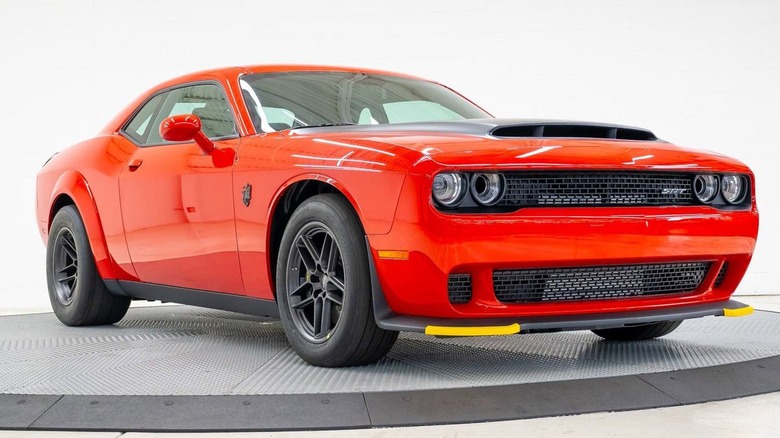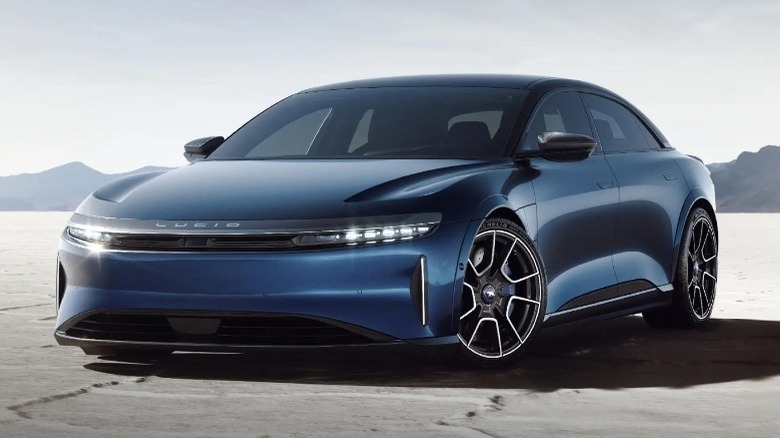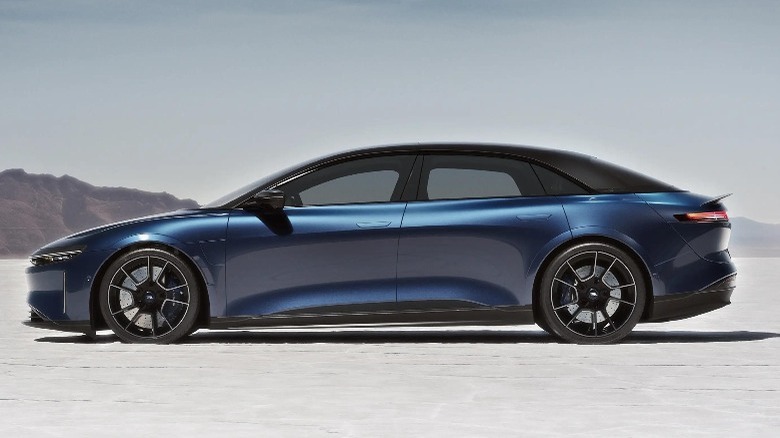Dodge Demon 170 Vs. Lucid Air Sapphire: Which Car Is Faster Over The Quarter Mile?
In a head-to-head competition, which would be faster in a drag race: the fastest production electric vehicle or the fastest production ICE machine boasting insane horsepower? With electric motors known for lightning-quick spin-up, the question seems easily answered in favor of EVs. But could the EV's big, heavy batteries — like extra saddle weight added to a fast race horse to handicap it — erase that instant acceleration advantage?
The fastest production car, based on 0-60, is the 2023 Dodge Challenger SRT Demon 170. The rear-wheel-drive Demon has a massive 6.2-liter Hemi V8 boosted with a screaming 3.0-liter supercharger that can empty the fuel tank in under seven minutes, pedal to the metal. The modified Hellephant C170 V8 can also produce 1,025 total horsepower and 945 lb.-ft of torque when the car is running on E85 gasoline. Coupled with Mickey Thompson drag radials and drag-tuned suspension from Dodge, this beast is unbelievably fast off the mark.
On a drag strip with extra-grip VHT coating, and driven by a racing professional, Dodge sent the 4,268-pound Demon to 60 from zero in 1.66 seconds, with a quarter mile time of 8.91 seconds, when it reached 151.17 mph. Is that fast enough to beat — or tie — the fastest production EV?
2024 Lucid Air Sapphire
The Demon 170 comes at you shrieking, in aggressive colors like Octane Red, Plum Crazy, and Destroyer Gray. The Lucid Air's Sapphire trim of this luxury electric super-sports sedan glides quietly onto the scene in just the one color, a stately metallic blue. It knows it's got speed, and it doesn't need to yell.
The Sapphire runs on Lucid's first three-motor power train — two motors for the rear wheels and one up front — for a combined 1,234 horsepower. Like the Demon, the Sapphire features track-tuned suspension. In this case, stiffer front and rear springs, and bushings, as well as traction and stability control to keep drivers on track. Or on the road. Lucid includes a Track Mode in its driver-selected options, and a choice of sub-modes — Dragstrip, Hot Lap, Endurance — to optimize performance with preset tweaks to torque vectoring, suspension, and more.
It all comes together to launch this 5,336-pound car from 0-60 mph in a 1.89-second blink-of-an-eye, and through the quarter mile in 8.95 seconds at 158 mph. But would these stats hold up in a real-world match-up with the world's fastest-accelerating production ICE? Let's see.
The Test and the Winner
The American automotive membership, insurance, and media company Hagerty stacked these two vehicles up against each other on a straight road and on a drag strip to see how real-world factors influenced the cars' reported performances. The results are tallied in a YouTube video documenting the difficulties in comparing the two vehicles, in part because they behave so differently. The Lucid Sapphire is so computer-automated, the launch and traction control are handled for the driver. The Dodge Demon 170 also has Launch Control, however, a trained driver was chosen for this test to achieve its fastest start.
In the first test, a 0-60, the Sapphire exorcised the Demon in 2.1 seconds on a straight asphalt track according to Hagerty. The Demon did astonishingly well at 0-60 in 3.7 seconds — it just couldn't match the Sapphire. On that same track the Lucid ran the quarter mile in 9.2 seconds at 158 mph, to the Dodge's 11.2 seconds at 139 mph.
In a separate test at Famoso Dragstrip, on the prepped sticky track that the Demon prefers to give its giant rear dragstrip wheels more grip, the Sapphire still easily triumphed. The Dodge needed 9.721 seconds to reach 143.72 mph at the quarter-mile mark, while the Lucid covered it in 9.002 seconds at 155.57 mph. Despite being a half a ton heavier than the Demon, the Sapphire proved to be America's fastest accelerating production car.


